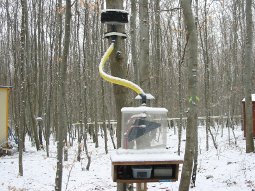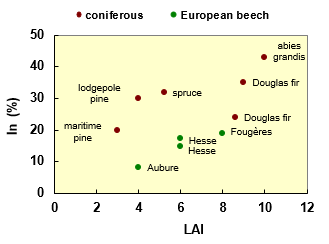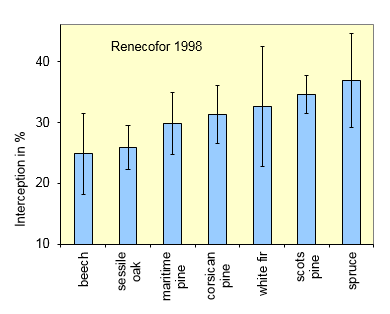
BILJOU
Forest water balance model
 - Silva Joint Research Unit
- Silva Joint Research Unit
Precipitation interception
How is this defined?
Precipitation interception refers to water, in liquid or solid form, that is intercepted by tree crowns, both leaves and wood bodies, before it falls to reach the soil. During this process of precipitation, water will enter into the ecosystem by several paths :
- one part enters directly by falling between the leaves to reach the soil, a process known as throughfall
- another fraction will evaporate during and following rainfall
- when the storage capacity of canopy is at full capacity, one fraction will fall to the soil one fraction, i.e. the stemflow, will flow along the sides of the trunk to the reach the ground
Note : We have chosen not to address snow interception, a phenomenon which is to date not fully understood and supported by surprisingly few published studies, nor do we address fog interception (production of liquid that will fall from the canopy to reach the soil).
How is this flow measured? What unit is used for this measurement?
Interception cannot be directly measured but rather is calculated as being the difference between incident
rainfall and throughfall, by using the following formula:
In = Pi – Ps - Pt, in which In represents the interception, Pi the incident rainfall, Ps the
rainfall which reaches the soil through the canopy and Pt, the stemflow.


Above : A system for collecting rain flowing down the trunks (photo UR BEF, INRA-Nancy).
Opposite : Measuring rain that reaches the ground by using a network of rain gauges for direct reading.
Precipitation interception is expressed in mm of water. For example, rainfall rendering 5 mm of water can lead to interception of 1 mm for a net gain of 4 mm for the forest. In is often expressed as a percentage of incident rainfall: In our example rain interception is 20%.
How is this water flow controlled?
Rainfall interception is interpreted by its physical aspects and depends on the intensity of the rainfall, on the leaf development (leaf area index, see the page Phenology and Leaf Area index) and on climatic conditions. During and after a rainy period, the evaporation rate will depend on the energy arriving at the crowns that can be measured by potential evapotranspiration (PET, see the page Meteorology).
 Relationship between rainfall interception (% of the incident rainfall) and leaf area index (LAI) taken from European beech and conifer stands.
Relationship between rainfall interception (% of the incident rainfall) and leaf area index (LAI) taken from European beech and conifer stands.
Variation in interception in stands relates to their leaf area index (see figure), but this relationship is complex: it has been observed that if on the whole In increases with LAI, some stands will show higher interception rates than expected. This is particularly true for shallow pine canopies or stands that have just experienced thinning.
Note : during the interception process when leaves or needles are wet, tree transpiration slows or stops altogether. This is taken into account by the Biljou model.
How does quantity vary over time?
With the start of rainfall, the canopy begins to accumulate water on its interception surfaces. When these surfaces start to saturate, water then flows downwards. This defines the saturation capacity of a canopy, which is the maximum amount of water that can be stored. Typically this capacity is between 1 and 2 mm: it is higher for coniferous with high leaf area index and lower in broad-leaved stands.
How does interception vary spatially?
Rainfall interception is spatially a highly variable phenomenon and is linked to heterogeneity in the canopy structure. Measurements show that, just following rainfall, some rain gauges placed below the canopy capture very little water, while others receive more than the incidental rainfall! This phenomenon is known as the funnel which is rainfall that has been locally concentrated by preferential flows in the crowns. Aussenac (1970) also showed that throughfall depends on the distance from the canopy to the trunk.
A few key figures
Rainfall interception is highly variable and is dependent on species, management techniques, climate and season variability.
However, we can provide a few ranges. In temperate climates, rainfall interception varies from 15 to 40% of the incident rainfall.
Overall, conifers intercept more rainfall (In representing between 30 and 40%) than deciduous trees (In representing between 15 and 30%)
for two main reasons: conifer stands generally show a higher leaf area index and, with the exception of larch, they bear leaves throughout the year.
Thus, in the same climate conditions, evergreen stands are often characterized by lower water availability in the soil than deciduous forests.
Additionally, stemflow (Pt) is highly dependent on tree species. Two extreme examples are beech, which has
smooth bark allowing Pt to reach or exceed 10% of the incident rainfall, as opposed to species with coarse
bark, such as oak, where the Pt represents only about 1 to 2% of rainfall. When stemflow is relatively low, this water
flows remains in the soil at the base of the tree.

Mean values of rainfall interception as % of incident rainfall measured in RENECOFOR stands in the French forest service observation network.
Useful References
![]() Aussenac G (1970) Action du couvert forestier sur la distribution au sol des précipitations. Annales
des sciences forestières, 27 (4), 383-399.
Aussenac G (1970) Action du couvert forestier sur la distribution au sol des précipitations. Annales
des sciences forestières, 27 (4), 383-399.
![]() Aussenac G et Boulangeat C (1980) Interception des précipitations et évapotranspiration réelle dans
des peuplements de feuillus (Fagus sylvatica L.) et de résineux (Pseudotsuga menziesii (Mirb) Franco).
Annales des sciences forestières, 37 (2), 91-107.
Aussenac G et Boulangeat C (1980) Interception des précipitations et évapotranspiration réelle dans
des peuplements de feuillus (Fagus sylvatica L.) et de résineux (Pseudotsuga menziesii (Mirb) Franco).
Annales des sciences forestières, 37 (2), 91-107.
![]() Ulrich E, Lelong N, Lanier M, Schneider (1995) Interception des pluies en forêt : facteurs déterminants.
Interprétation des mesures réalisées dans le sous-réseau CATAENAT de RENECOFOR. ONF, Bulletin technique n°30.
Ulrich E, Lelong N, Lanier M, Schneider (1995) Interception des pluies en forêt : facteurs déterminants.
Interprétation des mesures réalisées dans le sous-réseau CATAENAT de RENECOFOR. ONF, Bulletin technique n°30.
![]() Llorens P (1997) Rainfall interception by a Pinus sylvestris forest patch overgrown in a Mediterranean mountainous
abandoned area .2. Assessment of the applicability of Gash's analytical model. Journal of Hydrology 199: 3-4.
Llorens P (1997) Rainfall interception by a Pinus sylvestris forest patch overgrown in a Mediterranean mountainous
abandoned area .2. Assessment of the applicability of Gash's analytical model. Journal of Hydrology 199: 3-4.
![]() Loustau D, Berbigier P, Granier A, Elhadjmoussa F (1992) Interception loss, throughfall and stemflow in a maritime pine stand.
1.Variability of throughfall and stemflow beneath the pine canopy. The HartX-Synthesis: an experimental approach to water and
carbon exchange of a Scots pine plantation. Journal of Hydrology 138: 449-467.
Loustau D, Berbigier P, Granier A, Elhadjmoussa F (1992) Interception loss, throughfall and stemflow in a maritime pine stand.
1.Variability of throughfall and stemflow beneath the pine canopy. The HartX-Synthesis: an experimental approach to water and
carbon exchange of a Scots pine plantation. Journal of Hydrology 138: 449-467.
![]() Rowe L K (1983) Rainfall interception by an evergreen beech forest, Nelsin, New Zealand. Journal of Hydrology, 66, 143-158.
Rowe L K (1983) Rainfall interception by an evergreen beech forest, Nelsin, New Zealand. Journal of Hydrology, 66, 143-158.

